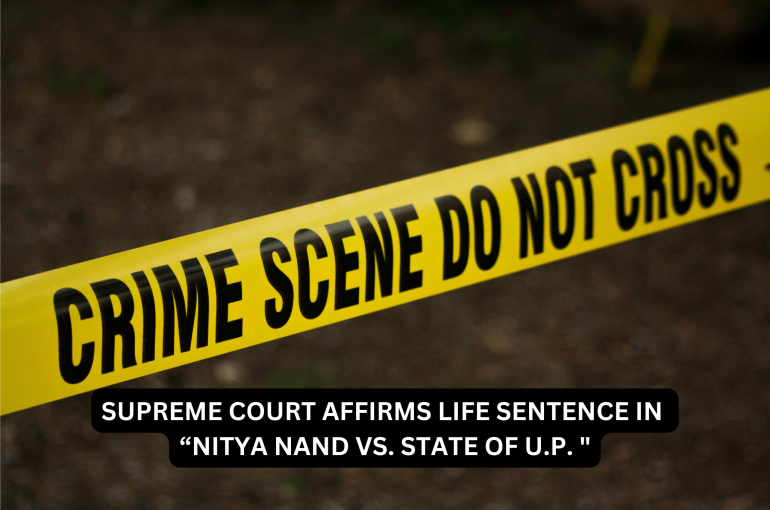SUPREME COURT AFFIRMS LIFE SENTENCE IN “NITYA NAND VS. STATE OF U.P. “
The Supreme Court of India, in the matter of Nitya Nand v State of UP, delivered its judgement on 04/09/2024 which was decided by a bench of Abhay S. Oka and Ujjal Bhuyan. The Apex court held that the Appellant was guilty of murder despite his claiming that he was part of a conspiracy but did not have the mens rea to take the life of the deceased Satya Narain.
Facts of the Case
The Appellant, Nitya Nand, along with others, was convicted for the murder of Satya Narain in Uttar Pradesh. The dispute arose from a family property conflict between three brothers—Shree Dev, Satya Narain, and Laxmi Narain—after Laxmi Narain, who was childless and executed a will in favor of Satya Narain’s sons. This angered Shree Dev and his sons, leading to enmity between the families.
On the day of the incident, the Appellant, along with his father Shree Dev and 3 brothers attacked Satya Narain near the Ganga Ghat. All the accused were armed with sharp weapons and carried a country-made pistol. Satya Narain was assaulted with sharp weapons, resulting in multiple fatal injuries. The Appellant fired his pistol in the air to prevent rescuers from approaching the crime scene, after which the accused fled.
Trial Court Proceedings
An FIR was lodged, and charges were framed under the Indian Penal Code under Sections 147 (Punishment for rioting) 148 (Rioting, armed with deadly weapon), 149 (Every member of unlawful assembly guilty of offence committed in prosecution of common object) and 302 (Punishment for Murder) The Sessions Court found the Appellant and others guilty. Shree Dev was convicted under Sections 147 and 302/149 IPC. His 3 sons including the Appellant were convicted under Sections 148 and 302/149 IPC.
The Trial Court sentenced the Appellant and other accused to life imprisonment for murder and imposed fines.
High Court Appeal
The Appellant approached the High Court on the ground that the eyewitness testimonies were credible and consistent, corroborating the prosecution’s case. The court also held that the appellant was part of an unlawful assembly with the common object to kill Satya Narain, making him vicariously liable under Section 149 IPC, even though he did not directly inflict injuries.
The High Court after examining the facts and hearing the parties held that the Appellant and the co-accused who had challenged the conviction before the Allahabad High Court was guilty. The High Court upheld the conviction, agreeing with the Trial Court that the prosecution had established the case beyond reasonable doubt.
Appeal to the Supreme Court
The Appellant, dissatisfied with the High Court’s decision, filed a Special Leave Petition (SLP) before the Supreme Court. The Court granted leave to Appeal but rejected the Appellant’s request for bail.
Judgment
The Supreme Court dismissed the appeal and upheld the Appellant’s conviction under Sections 148 and 302/149 IPC. The Court observed that the Appellant was part of an unlawful assembly whose common object was to kill Satya Narain. Under Section 149 IPC, all members of the unlawful assembly are liable for the acts committed by any member of that assembly in pursuit of the common object.
The Supreme Court cited previous judgments, noting that an individual can be convicted under Section 149 IPC even if they did not personally inflict injury. In this case, the Appellant’s firing in the air to facilitate the escape of the other accused was sufficient to establish his involvement in the common object.
The testimonies of Prosecution Witnesses were found reliable. Both witnesses clearly stated that the Appellant was present and fired a pistol to prevent others from intervening. This act was considered part of the unlawful assembly’s objective to kill Satya Narain. The Supreme Court held that the non-recovery of the firearm or empty cartridges did not weaken the Prosecution’s case, as the Appellant was convicted on the basis of eyewitness accounts and his presence at the crime scene.
The Court acknowledged that some witnesses were not examined. However, the non-examination of these witnesses did not create any reasonable doubt about the Appellant’s guilt, as there was sufficient evidence from other sources to prove beyond reasonable doubt that the Appellant and his co-conspirators were guilty of the crime.
Conclusion
In the present case of Nitya Nand Vs. State of UP [CRIMINAL APPEAL NO. 1348 OF 2014] the Supreme Court reaffirmed the Appellant’s conviction under Sections 148 and 302/149 IPC, concluding that Nitya Nand was part of an unlawful assembly that had the common object of killing Satya Narain. His actions, although not directly causing physical injury, were essential in the execution of the crime, making him liable under Section 149 IPC. The appeal was therefore dismissed, and the Appellant’s life imprisonment sentence was upheld.
Ashita
Associate
The Indian Lawyer & Allied Services





































Leave a Reply